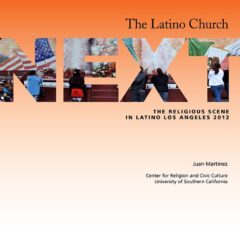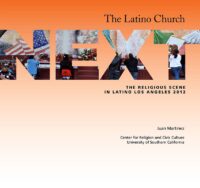The greater Los Angeles area serves as an excellent location to look at how Pentecostalism has developed among Latinos. Modern Pentecostalism began in Los Angeles, but now new generations of adherents are bringing Pentecostalism back to Los Angeles in various new forms. The most common forms of Latino Pentecostalism in Los Angeles are the churches tied to American Pentecostal churches. All of the U.S. Pentecostal denominations have Latino churches in Los Angeles, including traditionally African American denominations like the Church of God in Christ (COGIC). But there are also many churches from Latino Pentecostal denominations, such as the Apostolic Assembly, Concilio Latino Americano de Iglesias Cristianas (CLADIC), El Concilio Latinoamericano Internacional de la Iglesia de Dios Pentecostal de Nueva York (CLANY) or the Asamblea de Iglesias Cristianas. There are also Latino churches linked to denominations that emerged from the charismatic renewal movement, such as Vineyard and Calvary Chapel.
In Los Angeles one can also find various forms of immigrant-based Latino Pentecostal movements. A variation on this transnational theme is when a church, such as Robert Schuller’s Crystal Cathedral in Garden Grove, brings someone like Dante Gebel to pastor its Spanish-language congregation. There are many Latin American pastors, conference speakers, and musicians who are regularly in the Los Angeles area. Cross-fertilization of influences also occurs because many Latino pastors travel to Latin America to preach and give conferences on a regular basis. The growth of Latino Pentecostalism in Southern California is also creating new types of relationships between churches in the area and within the various denominations.
There are now at least ten Latino Pentecostal churches in the region with over 1,000 members, including megachurches like Iglesia en el Camino/Church on the Way where the Spanishlanguage congregation is now larger than the English one that gave it birth, and many of those who attend the English-language congregation are Latinos. Of course, most Latino congregations are small. Some attempt to imitate the larger churches, while others see the large churches as threats. Networks of small churches sometimes affiliate themselves with one of the large churches. Others complain that large churches grow at the expense of the smaller congregations in the area. Some of the small churches see themselves as alternative congregations, while others would like to grow into megachurches.
In addition, a number of congregations are on the edges of the Latino Pentecostal community, such as Victory Outreach. Many of these churches do not openly identify themselves as Latina, though the vast majority of their members are Latinos and their services often have a Latino cultural flavor. Related to these churches are the growing numbers of nonLatino churches that have a growing Latina presence.
Popular Pentecostalism challenges the official religious order, not by directly confronting the religious powers, but by offering a counter-narrative that is more compelling and that allows people to be active participants in God’s work in the world. This issue raises the question of acculturation in a different way. Are subversive Pentecostalisms an invitation to a new way of thinking about the church and its role in the world, or “merely” a counter-narrative that is discarded if those who are excluded find a way into the structures of power? Can the tendency to become a “church” in the sociological sense be avoided?
These churches grow among Latinas because they speak to a lived experience of God. Most Latinos experience God as one who walks with them in the journey of life. That experience is lived out in Pentecostal worship and church life. These congregations are one of the few places where Latinas can express their faith in their own way and lead their own congregations. For many immigrants these churches also become their new extended families. Because of these characteristics Latino Pentecostal congregations are increasingly attractive, and many non-Pentecostal churches are imitating their styles.
Almost all non-Pentecostal Protestant denominations and churches in Los Angeles also have a Latino presence. Most have churches or parishes that focus on the Latino community or at least offer services in Spanish. There are also many Latinos in “non-Latino” churches. None of them have a presence as large as that of the Pentecostal groups, but several of the denominations— such as the American Baptists, Nazarenes, Adventists, Southern Baptists and Methodists—all have a substantial number of Latino churches and also many Latinos in traditionally Euro-American congregations.
To be Latina and Protestant is to be at a num – ber of crossroads and points of encounter: between Euro American North America and Latin America, between Euro American Protestantism and Latin American Catholicism, between the First World and the majority world, between a dying Christendom and the vital new Christian expressions of the global south, between changing notions of the nation-state and the new transnational reality of migrant peoples, and between old racialized understandings of life together in the United States and the new multicultural and intercultural relationships that are developing. Yet the category “Latino Protestant” is so diverse that there are often at least a few Latina Protestants on both sides of all these encounters. Latino Protestants often seem no more united than the diversity reflected in the terms Latino and Protestant. Yet there is a common thread of history and a common understanding of a personal encounter with God. It is that divine encounter that continues to provide meaning to many who live at these crossroads.
Some of the distinctive characteristics of Latino Protestantism include:
1. Believers’ Church Perspective For the vast majority of Latina Protestants, infant baptism harkens back to their personal Roman Catholic past in which they were identified as Christians because they were born into a Catholic family and baptized. Their faith became real in their own lives when they made a personal commitment and sought baptism.
2. Pentecostal Influence on Protestantism Latino Protestants are much more likely to be part of Pentecostal/charismatic churches than the U.S. Protestant population at large. Latina evangelical, mainline and Catholic churches are also more likely to have been influenced by Pentecostal or charismatic worship styles than their counterparts in non-Latino churches. In most Latino churches worship has a distinct Pentecostal or charismatic flavor to it, which reflects a worldview in which God and spiritual beings are very much a part of human existence.
3. Evangélico Self-Identity Most Latina Protestants use evangélico as the self-designation that they share with other Protestants, including those of different theological traditions. This usage has its roots in Latino Protestant history and reflects how the terms are used in Latin America, but often creates confusion in the U.S. setting. Evangelico is not synonymous with evangelical.
4. Belief in the Power of Prayer Prayer and the belief in God’s intervention in daily life is part of the Latino Protestant experience. People pray expecting God to intervene.
5. Conversion-Oriented Faith Commitment Most Latino Protestants have had a clearly defined conversion experience. They can tell others about when they “accepted Jesus,” when they were baptized and, if they are Pentecostals, when they “received the Holy Spirit.”
6. A People of the Book The Bible has always been a key part of Protestantism. The people’s access to the book and the belief that individuals could understand its meaning, through the power of the Holy Spirit, were key parts of the Protestant Reformation.
7. Evangelism as Part of Being a Christian Because a high percentage of Latino Protestants are converts or from conversion-oriented and believers’ church denominations, evangelism and witness tend to be more crucial for them than for the Protestant population at large. One of the reasons for the growth of Latina Protestant – ism in Los Angeles has been the evangelism born from the commitment of the converted.
8. Importance of the Local Church Community Latino Protestants in Los Angeles go to church more often than their Euro American counterparts or than Latino Catholics. Most Latino Protestants assume that the church is their place of primary allegiance; God comes first. They tend to understand their faith as linked to a concrete community of people. The local church is also the primary social network for many.
Juan Martinez is a former fellow with the USC Center for Religion and Civic Culture.


